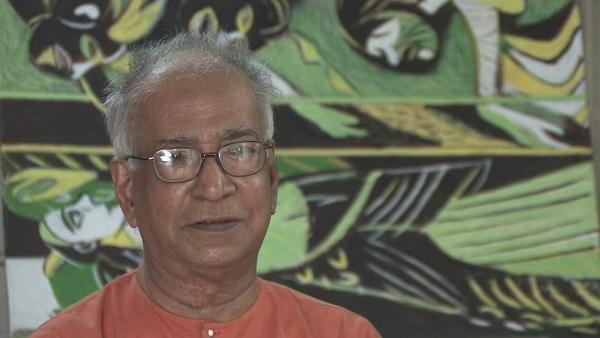NEXT STORY

From Baroda to writing and the Slade School of Art, London
RELATED STORIES

NEXT STORY

From Baroda to writing and the Slade School of Art, London
RELATED STORIES


|
Views | Duration | |
|---|---|---|---|
| 21. Organising an exhibition in Delhi | 54 | 09:28 | |
| 22. Working with Benode Bihari Mukherjee | 58 | 03:25 | |
| 23. Interest in Italian painting | 46 | 04:03 | |
| 24. Satyajit Ray | 92 | 02:36 | |
| 25. Leaving Santiniketan for Baroda | 42 | 01:51 | |
| 26. The partition of Indian and going to Baroda University | 39 | 04:11 | |
| 27. Life at Baroda | 58 | 04:06 | |
| 28. From Baroda to writing and the Slade School of Art, London | 48 | 02:52 | |
| 29. My wife, Susheela | 75 | 07:13 | |
| 30. London, language, tradition and the various influences on my art | 73 | 05:22 |


When I came here, I found that the situation was very congenial and you were together with a number of people who were very friendly who wanted to work together and then build up a faculty which had a sort of a personality of its own, and then where teaching would not interfere with your own work and then which gave you enough time to do that, and also where you could, from time to time, re-examine what you were doing. So it worked quite well. For the first... and then luckily for us at that time, the relationship between this faculty and the administrators was very congenial. They were very supportive, and they heard whatever you had, they tried to solve whatever problems came up. So the first 15 years the faculty was able to make a kind of impact on the national scene. That’s how it happened.
Was there a more developed critical dimension to Baroda from the beginning than in Santiniketan?
Well, really speaking, from Santiniketan to Baroda, on one side Baroda got various kind of, let’s say, attitudes and inputs from Santiniketan in the sense that there should be a certain amount of informality in teaching. It should not be too highly curriculum-based, and that it should be more related on the talent of each person. So the course or whatever, the programme, should be broad enough, and in the beginning we all tried to do away with tests. So it will be only, it is the first institution that said that the adjustment should be made on the basis of an exhibition and not... and we were all more sort of ambitious at one time thinking that we will keep a kind of day-to-day record of each one’s development and things of that kind. So we had a file on each student. We didn’t, and it continued for a long time of that sort of work, but they tried, we used the grading credit system that was then current in the American universities. So, on one hand, this faculty learnt a few things from Santiniketan and on the other, it learnt a few things from the American university programmes. So, together, in a kind of structured university like that of Baroda, I tried to fashion sort of an educational setup that will be kind to both student and teacher. I mean, that’s how the whole thing happened. So, we were able to make an impact at that time, and I should say, by working in that setup, I myself learnt a lot. In fact, I would not have thought in terms of thinking on certain lines if I had not worked with young people like that and tried to explain to myself the questions they asked, of this kind.
KG Subramanyan (1924-2016) was an Indian artist. A graduate of the renowned art college of Kala Bhavana in Santiniketan, Subramanyan was both a theoretician and an art historian whose writings formed the basis for the study of contemporary Indian art. His own work, which broke down the barrier between artist and artisan, was executed in a wide range of media and drew upon myth and tradition for its inspiration.
Title: Life at Baroda
Listeners: Timothy Hyman
Timothy Hyman is a graduate of Slade School of Fine Art, London, in which he has also taught. In 1980 and 1982, he was Visiting Professor in Baroda, India. Timothy Hyman has curated many significant art exhibitions and has published articles and monographs on both European and Indian artists.
Duration: 4 minutes, 7 seconds
Date story recorded: 2008
Date story went live: 10 September 2010